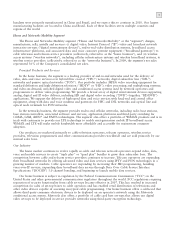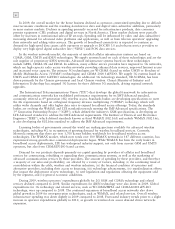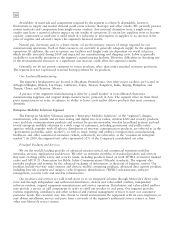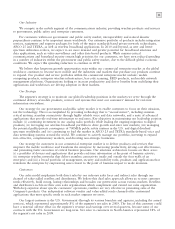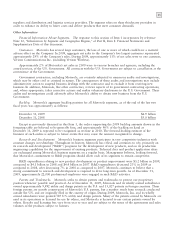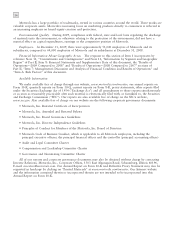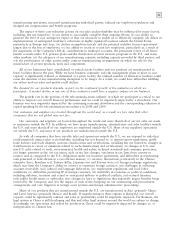Motorola 2009 Annual Report Download - page 22
Download and view the complete annual report
Please find page 22 of the 2009 Motorola annual report below. You can navigate through the pages in the report by either clicking on the pages listed below, or by using the keyword search tool below to find specific information within the annual report.
14
Intellectual Property Matters
Patent protection is extremely important to the segment’s operations. The segment has an extensive U.S. and
international portfolio of patents relating to its products, systems, technologies and manufacturing processes,
including recent research developments in scanning, information collection, mission critical two-way radio
communication, network communications and network management. We have also filed additional patent
applications in the U.S. Patent and Trademark Office, as well as in foreign patent offices.
The segment licenses some of its patents to third parties and this revenue is not significant. Motorola is also
licensed to use certain patents owned by others. Royalty and licensing fees vary from year to year and are subject
to the terms of the agreements and sales volumes of the products subject to licenses.
We actively participate in the development of open standards for interoperable, mission-critical digital
two-way radio systems. We have published our technology and licensed patents to signatories of the industry’s
two primary memorandums of understanding defined by the Telecommunications Industry Association (‘‘TIA’’),
Project 25, European Telecommunications Standards Institute (‘‘ETSI’’), and TETRA.
Notwithstanding the expiration of certain patents and the resulting potential for increased competition for
some of our products in the future, we believe that our extensive patent portfolio will continue to provide us with
a competitive advantage. Furthermore, we believe we are not dependent upon a single patent or a few patents.
Our success depends more upon our proprietary know-how, innovative skills, technical competence and
marketing abilities. In addition, because of changing technology, our present intention is not to rely primarily on
patents or other intellectual property rights to protect or establish our market position. However, the segment
continues to litigate against competitors to enforce its intellectual property rights in certain technologies and is
currently involved in several such lawsuits. For additional information relating to patents, trademarks and
research and development activities with respect to this segment, see the discussion under ‘‘Other Information’’.
Inventory, Raw Materials, Right of Return and Seasonality
The segment’s practice is to carry reasonable amounts of inventory to meet customers’ delivery requirements
in a manner consistent with industry standards. The segment provides custom products which require the
stocking of inventories and large varieties of piece parts and replacement parts in order to meet delivery and
warranty requirements. To the extent suppliers’ product life cycles are shorter than the segment’s, stocking of
lifetime buy inventories is required to meet long-term warranty and contractual requirements. In addition,
replacement parts are stocked for delivery on customer demand within a short delivery cycle. At the end of 2009,
the segment had a lower inventory balance than at the end of 2008, as the Company implemented several
initiatives to efficiently utilize its on-hand inventory.
Availability of materials and components required by the segment is relatively dependable, however,
fluctuations in supply and market demand could cause selective shortages and affect results. We currently procure
certain materials and components from single-source vendors. A material disruption from a single-source vendor
may have a material adverse impact on our results of operations. If certain key suppliers were to become capacity
constrained or insolvent as a result of the ongoing global financial crisis, it could result in a reduction or
interruption in supplies or an increase in the price of supplies and adversely impact the segment’s financial results.
Natural gas, electricity and, to a lesser extent, oil are the primary sources of energy for our manufacturing
operations. Each of these resources are currently in adequate supply for the segment’s operations. In addition, the
cost to operate our facilities and freight costs are dependent on world oil prices, which steadily increased during
2009 and impacted our manufacturing and shipping costs. Labor is generally available in reasonable proximity to
the segment’s manufacturing facilities. However, difficulties in obtaining any of the aforementioned resources or a
significant cost increase could affect the segment’s results.
Generally, the segment’s contracts do not include a right of return, other than for standard warranty
provisions. For new product introductions, we may enter into milestone contracts providing that the product
could be returned if we do not achieve the milestones. Due to buying patterns in the markets we serve, sales tend
to be somewhat higher in the fourth quarter.
Our Facilities/Manufacturing
The segment’s primary offices are located in Schaumburg, Illinois and Holtsville, New York. Our other major
facilities are located in: Penang, Malaysia; Reynosa, Mexico; Krakow, Poland; Berlin, Germany; and Arad, Israel.
A portion of the segment’s manufacturing is done by a small number of non-affiliated electronics manufacturing



